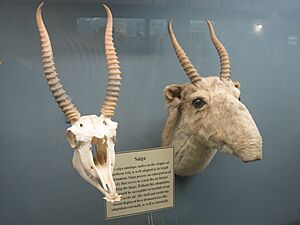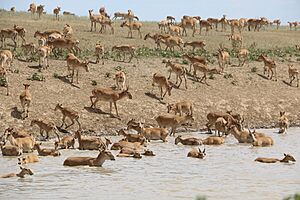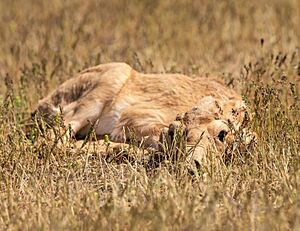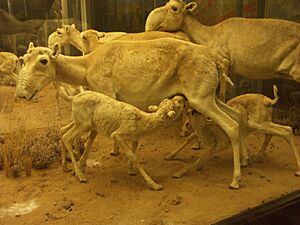Saiga antelope facts for kids
Quick facts for kids Saiga antelope |
|
|---|---|
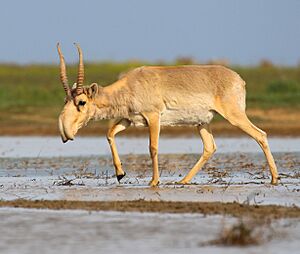 |
|
| A male saiga antelope in Russia | |
 |
|
| A female saiga antelope in Ukraine | |
| Conservation status | |
| Scientific classification | |
| Subspecies | |
|
|
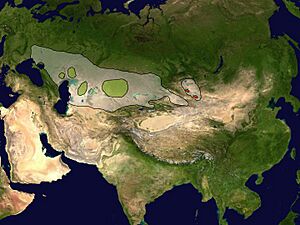 |
|
| Where saigas used to live (white) and where they live now (green and red). | |
| Synonyms | |
The saiga antelope (pronounced SIGH-guh), or just saiga, is a special type of antelope. Long ago, it lived across a huge area of the Eurasian steppe. This stretched from the Carpathian Mountains in the west to Mongolia in the east. During the Ice Age, saigas even lived from the British Isles all the way to Alaska.
Today, most saigas (called S. t. tatarica) are found in parts of Russia and Kazakhstan. Some travel south to Uzbekistan in winter. Another group, the Mongolian saiga (S. t. mongolica), lives only in western Mongolia. Sadly, saigas have disappeared from many places they once lived, like Ukraine and China.
Contents
Understanding Saiga Antelopes
The scientific name for the saiga is Saiga tatarica. This name was first given by Carl Linnaeus in 1766. The saiga is the only living animal in its group, called the Saiga genus.
Two Main Types of Saiga
There are two main types, or subspecies, of saiga:
- S. t. tatarica: This is also known as the Russian saiga. Today, you can find it in Central Asia.
- S. t. mongolica: This is the Mongolian saiga. It lives only in Mongolia. Sometimes, people think it might be a separate species.
Saiga Through Time
Fossils of saigas have been found mostly in central and northern Eurasia. Some of these fossils are very old, from nearly 100,000 years ago. Scientists have named several types of ancient saigas. However, newer studies suggest these old saigas were just different groups of the same species we see today.
Saiga fossils found in Crimea show they were around when the last Ice Age ended. It seems the saiga's body shape hasn't changed much since ancient times. Long ago, saigas lived across a huge area, from England and France to Siberia and Alaska.
What Saigas Look Like
The saiga is about 61–81 cm (24–32 in) (2 to 2.5 feet) tall at the shoulder. It weighs between 26–69 kg (57–152 lb) (57 to 152 pounds). Its body is usually 100 and 140 cm (39 and 55 in) (3 to 4.5 feet) long.
A Unique Nose
The most striking thing about a saiga is its nose! It has two large, close-set nostrils that point downwards. This nose looks a bit swollen. It helps the saigas breathe in dusty summers and warm up cold air in winter. Saigas also have dark marks on their cheeks and nose. Their ears are about 7–12 cm (2.8–4.7 in) (3 to 5 inches) long.
Changing Coats and Horns
A saiga's coat changes with the seasons. In summer, it's yellow to red, getting lighter on its sides. Mongolian saigas can be sandy colored. In winter, their coat turns pale grayish-brown. The hair grows longer in winter, forming a 12 to 15 cm (4.7 to 5.9 in) (5 to 6 inch) long mane on their neck. Saigas shed their fur twice a year, once in spring and once in autumn. Their tail is short, about 6–12 cm (2.4–4.7 in) (2 to 5 inches) long.
Only male saigas have horns. These horns are thick and slightly see-through. They are waxy-colored and have 12 to 20 clear rings. Russian saiga horns are 28–38 cm (11–15 in) (11 to 15 inches) long. Mongolian saiga horns are shorter, up to 22 cm (8.7 in) (9 inches) long.
Saiga Life and Habits
Saigas live in very large groups, called herds. They eat plants in semideserts, steppes, and grasslands. They can eat plants that are poisonous to other animals. Saigas can travel long distances and swim across rivers. However, they avoid steep or rocky areas.
Reproduction and Life Cycle
The mating season for saigas starts in November. During this time, male saigas fight to attract females. The strongest male will lead a group of five to ten females, sometimes even up to 50. In springtime, many mothers gather together to give birth. About two-thirds of the time, a mother will have twins. The rest of the time, they have one calf.
Saigas are known for their long journeys across the steppes. These migrations help them escape natural dangers.
Predators
Wolves are a big threat to saigas. Younger saigas are hunted by foxes, steppe eagles, golden eagles, and ravens.
Where Saigas Live Now
In the mid-2010s, the number of saigas dropped very quickly. Their population fell by as much as 95% in just 15 years. Because of this, they were listed as critically endangered. This means they were at a very high risk of disappearing forever.
However, in recent years, saiga numbers have grown a lot! In 2022, there were an estimated 1.38 million saigas in Kazakhstan. By December 2023, the total number of adult saigas worldwide was estimated to be between 922,600 and 988,500.
Why Numbers Changed
In May 2010, about 12,000 saigas died in Kazakhstan. This was thought to be from a disease called pasteurellosis. In May 2015, the same disease seemed to cause another huge die-off. More than 120,000 saigas died in central Kazakhstan. This was more than a third of all saigas in the world at that time.
But by April 2016, saigas started to recover. Their numbers in that area went from 31,000 to 36,000. By April 2021, a survey in Kazakhstan found that the saiga population had risen from about 334,000 to 842,000. This increase was partly because the government stopped poaching and created protected areas. In 2022, a charity reported that the population had reached 1.32 million.
Where They Used to Live
During the last Ice Age, saigas lived from the British Isles all the way to Alaska and Canada. They were an important animal for ancient cultures. Drawings of saigas have been found in cave paintings from 700 to 500 BC. Saiga bones were also found near old human settlements.
In the 14th to 16th centuries, there were many saigas in what is now Kazakhstan. But in the late 1800s, too many saiga horns were being sold. This led to a lot of hunting. The number of saigas dropped, and their travel routes changed. By the 1920s, they were almost completely gone.
However, saigas managed to recover. By 1950, there were two million of them in the steppes of the USSR. But after the USSR broke apart, their population fell again. This was due to uncontrolled hunting and the demand for their horns in traditional Chinese medicine.
Mongolian Saiga Habitat
The Mongolian saiga (S. t. mongolica) lives in a small area in western Mongolia. This area includes the Sharga and Mankhan Nature Reserves.
Dangers to Saigas
Saigas face several dangers that can harm their populations.
Illegal Hunting
The horns of the saiga antelope are used in traditional Chinese medicine. They can be sold for a lot of money. This high demand leads to illegal hunting, called poaching, and smuggling. Poaching has caused saigas to disappear from China, where they are a protected species.
In June 2014, officials in China found 66 boxes with over 2,300 saiga horns. These horns were worth about US$11 million. Experts say that stopping poaching needs to be a top goal for governments where saigas live.
Saigas have been hunted for a long time, even in ancient times, for food. Today, their horns, meat, and skin are still valuable. From 1955 to 1989, over five million saigas were hunted in Kazakhstan for their meat. In 2011, Kazakhstan banned saiga hunting until 2021 to help them recover. Saiga meat is said to be tasty and healthy, similar to lamb. Their skin is also used.
Man-Made Barriers
As farms and towns grow, the places where saigas live are getting smaller. Human settlements can block saigas from reaching water or their winter and summer homes. Saigas need to find new paths to their usual lands. Their travel routes now cross five countries and run into things like railways, ditches, mining sites, and pipelines. These barriers make it hard for them to move freely. There have been reports of saiga herds getting trapped by fences and starving.
Weather Changes
Saigas depend a lot on the weather because they travel so much. Harsh winters with strong winds or deep snow can stop them from finding grass to eat. Their population often drops a lot after very cold months. Recent climate changes have made the steppe drier. This means more than 14% of their grazing land is now dry and unusable. Also, small rivers in the steppe dry up faster, leaving only large lakes and rivers, which are often near human towns. High temperatures can also cause spring floods, where baby saigas can drown.
Mass Sickness Outbreaks
Past Events
It's not unusual for large groups of hoofed animals like saigas to die off suddenly. Several saiga die-offs happened in the 1980s, and one happened every year between 2010 and 2014. These deaths often happen when saigas gather to give birth, which is when they are most vulnerable. Newer research from a big die-off in 2015 suggests that warmer, humid weather caused bacteria, which are normally harmless in saigas, to enter their blood and cause a serious infection.
2015–2016 Outbreak
In May 2015, a very large number of saigas started dying from a mysterious illness. It was thought to be pasteurellosis. Once infected, all the saigas in a herd would die. An estimated 40% of the entire species died. By late May 2015, over 120,000 dead saigas had been found. At that time, the total population was only about 250,000.
Scientists later found that a bacterium called Pasteurella multocida was the cause of death. This bacterium is usually harmless in saigas. Scientists now believe that unusually warm and wet weather caused the bacteria to become dangerous and enter the saigas' bloodstream, leading to a severe infection called hemorrhagic septicemia.
Despite the huge loss, the saiga population in central Kazakhstan, where most deaths occurred, grew from 31,000 after the sickness to 36,000 by April 2016. In late 2016, many saigas also died in Mongolia. This was later confirmed to be a disease called goat plague.
Protecting Saigas
To help protect saigas, the Saiga Antelope Memorandum of Understanding was created in 2006. This agreement helps countries work together to save these animals.
Saigas in Zoos
Currently, only the Almaty Zoo in Kazakhstan and Askania-Nova in Ukraine keep saigas in captivity.
Images for kids



